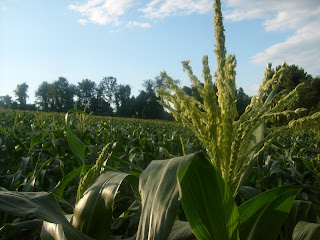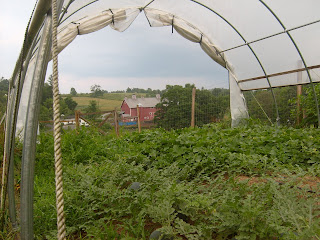As market failures persist and government is unable to provide the fix, communities1 are organizing. The Northeast Organic Farming Association (NOFA) is “an organization of consumers, gardeners, and farmers working together to create a sustainable regional food system which is ecologically sound and economically viable.”2 To understand how real this community is the Annual Summer Conference hosted at UMass (Amherst, MA) offers workshops, keynotes, a market and fair, night events, and local dining. The convergence is symbolic of the growing movement to make healthy foods available to all people and embrace environmentally-responsible stewardship of our Nation’s landscape.
The first workshop I sat in on at the 2010 conference was led by acupuncturist, herbalist, and Director of Goldenthread Herb Farm & Apothecary William Siff. Siff discussed their Farm-to-Pharmacy internship program and “sustainable, cost-effective, non-toxic, community-based healthcare model” adopted by Goldenthread. Unable to compete with market prices from imported manufactured ‘natural’ remedies from China, Goldenthread Herb Farm found its niche by placing education in the forefront. Each growing season, 20 to 25 interns pay full tuition for a 7 month intensive hands-on, academic, and clinical training on 4 acres of certified organic land growing medicinal herbs using biodynamic practices, and processing them using Chinese or ayurvedic tradition. The tuition in turn subsidizes production costs allowing CSA members to receive their local natural medicines at an affordable rate. 
On the first evening Sally Fallon Morell, founder of the Weston A. Price Foundation and author of Nourishing Traditions, gave her keynote address concerning salt. She mentioned fats, sugars, and animal products, decrying America’s obsession with low-fat, low-sugar, low- nourishment diets. She prescribed a traditional diet full of raw milk, cod liver oil, and animal fats, which certainly raised many an eyebrow in a conference hall freckled with vegetarians and vegans.
A less controversial yet equally concerning topic mentioned was the allegiance between associations that represent processed foods and federal regulatory bodies: the Food and Drug Administration (FDA) and United States Department of Agriculture (USDA). The USDA food pyramid first accommodated the vegetable oil industry post WWII during the agricultural Green Revolution when industrialization moved beyond factories onto the Nation’s farms. Margarine and hydrogenated oils replaced butter and unprocessed fats and sixty years of advertisements attacking animal fats were drawn up by the new industry.
Heeding a word of caution against the latest low-sodium craze, Sally revealed that the American Medical Association (AMA) is preaching that consumers should cut their sodium intake to reduce the risk of heart disease based on poor scientific research. She criticized the research connecting high sodium diets to heart disease as being blatantly skewed in data representation and control set-up. She explained the familiar story again: A new imitation salt additive has recently been developed that is cheaper than salt and used in a fraction of the amount. It is also a neurotoxin. Food items containing the additive will greet ailed, high blood pressured, and over-weight consumers with an enticing low-sodium branding as doctor recommended, while the nutrition facts will simply include the additive under ‘artificial ingredients’. Offering little faith in our public servants on the Hill, Sally forewarned against trusting processed foods and fad diets even when sponsored by medical authorities. Hence, she subtitled her book The Cookbook that Challenges Politically Correct Nutrition and the Diet Dictocrats.

The following day I attended a workshop led by two policy experts, Traci Bruckner of the Center for Rural Affairs (Nebraska) and Martha Noble of the National Sustainable Agriculture Coalition (DC), entitled “Growing Organic in USDA Conservation Programs”. The presentation was grounded on the premise that there is a pool of funding made available through the Natural Resource Conservation Service (NRCS) for farmers implementing best management practices. Organic and small scale farmers need to get more involved in the allocation process to receive funding. After reviewing the different programs, eligibility requirements, and criteria specific to organic agriculture our presenters ended with agreeably stating “We need you” to sit on State Technical Committees and within Local Working Groups to help our diversified farmers take advantage of the programs they help develop.
NOFA Policy Coordinator Steve Gillman and the National Sustainable Agriculture Coalition (NSAC) Senior Policy Associate Kate Fitzgerald, both real players in the game on the Hill, covered the workshop “Updates on Governmental Food Safety Initiatives and Effects on Farmers.” There has been a wrongly placed hysteria over the recent food safety bills moving through Congress. The fear of current food safety legislation stems from internet hear say that farmers will be so heavily regulated that small operations will be put out of business and organic farming will be completely outlawed. It seems as if “food safety” is the bi-word to get foods processed and, like all things, there is some truth in this.
H.R.2749 and S.510 propose amendments to the Federal Food, Drug and Cosmetic Act under the framework of the 2002 Bioterrorism Law. The bill merely addresses biological pathogenic contamination overseen by the FDA, with no discussion on pesticide contamination, otherwise regulated by the EPA. The concern resides in the definition of “facility” which is so vague even small farmers get clumped with factory operations. The FDA recognizes the limitations of the law’s language; however, the FDA is so underfunded and –staffed the agency is unable to fully enforce regulations upon every qualified farm.
NSAC has had policy personal guide the drafting process of the S.510 version of the bill, focusing specifically on the aspects of food safety legislation that relate to small scale growers. Facets of concern have been the definition of “facility,” the regulatory standards imposed upon produce, mechanisms for traceability from farm to table, and availability of training and technical support to small farms to help with regulatory compliance. Overall, the intent was to develop legislation that is flexible to the scale of the producer and, therefore, based on risk as a more reliable indicator for the need to regulate. It has been difficult to ensure that any regulation does not conflict with the National Organic Program or conservation and wildlife laws. NSAC has worked very hard to make improvements to the S.510 version of which NSAC and NOFA now advocate for. The same is not true for the H.R.2749 version.
By the end of 2010 a final bill will be passed which will take three years to come into full effect. Before this happens, the House and Senate versions will go to committee to be amalgamated into one bill. The House version is convoluted and detrimental to small farmers. Those in attendance of the workshop were encouraged to tend to our patriotic duties and contact legislators urging them to support the Senate version (U.S. Capitol Switch Board Contact: 202.224.3121).
As vital as umbrella organizations are to participating in the political game, individuals must also feel empowered to act. The solutions to food security issues are local solutions. This is in part due to the uniqueness of food. When the FDA approves food stuffs that are said to be “edible”, vitality and nutrient quality, environmental and social impacts are void characteristics still, which leads us down the path of a national obesity, diabetes, and heart disease epidemic, biodiversity loss, air and water pollution, and land degradation.
The July 2010 issue of Natural Awakenings ran an article entitled “Locavore Nation: Savor the Reign of Regional Foods”. The article poured over the health benefits of eating regionally grown produce and the historical context in which different peoples settled different regions of the country with blooming cultures of wine growing in California, tapping sugar maples in Vermont, raising dairy cattle in the Northeast and honey production across the Midwest set root. Regional American food cultures sprouted regionally infused with the diets of indigenous peoples. The overall argument in favor of locally grown or raised is the nutritional superiority of foods grown in their ideal microclimate and the lack of need to process, artificially preserve or irradiate to enhance shelf life since foods are traveling shorter distances from farm to market when locally or regionally sourced. Supporting local agriculture also propagates local economies and protects farmland from development. Research is necessary to expedite the process of finding the most appropriate and effective strategies to address food security and support an alternative regional-foods infrastructure in this country. These strategies are supposed to come out of our public land grant institutions. However, the agenda of agricultural research is being privatized by the “Monsanto’s of the world”- as phrased by a NOFA conference coordinator. Forefront university research still falls within the dominant conventional agricultural paradigm of intensive inputs replacing human labor stemming from the Green Revolution - a flawed, unsustainable paradigm. Even organic research can follow the dominant model. For example, Ruth Hazzard of Pennsylvania’s agricultural extension agency lectured a packed room about “Insect Pests on Vegetables.” Only the major OMRI approved organic sprays were discussed for pest control; however, organic and biodynamic farmers have a plethora of other options. Thus, ingenuitive small farmers are very much experimenting themselves.
Real Food Campaign (RFC) Director Dan Kittredege, quite well known in the northeast small farmers’ community for his valiant efforts, and ecological engineer and RFC Research Coordinator Tad Montgomery presented “The Science of Quality and a Strategy for Nutrient Dense Standards.” Nutrient dense cropping is not only a reappearance of age-old agricultural practice, but encapsulates a paradigm shift premised on soil vitality correlating with nutritionally dense and healthy produce; healthy food consumption correlating with a healthy society.
To give credence to the methods already supported by anecdotal evidence, the RFC is sponsoring scientific research using 15 volunteer growers implementing nutrient dense cropping practices. Each farm is to strictly follow proper agronomic protocol and scientific set-up as designed by the RFC. Kittredge’s goal is to provide empirical evidence in favor of nutrient dense cropping in the hopes to standardize the methods for eventual certification, similar to organic standards, to incentivize farmers to adopt such practices. By no means is Kittredge attempting to re-create the wheel though. He has spent the past year traveling the country connecting with researchers in the universities trying to coalesce the knowledge and expertise already out there.
If small scale farmers and their labor intensive practices are what will be the foundational solution to our food revolution, Cuba is a prime example. Saturday evening’s keynote speaker Catherine Murphy shared a tale I had never heard before: Once upon a time Cubans were a conquered peoples swayed into inviting in industrial agriculture. Land was privatized to be owned by American-based transnational companies utilizing input intensive practices heavily reliant upon foreign petrochemical imports. Then, the Soviet Union seceded and the Special Period began. Soviet satellite countries were forbidden from trading with Cuba and the United States tightened their embargo at a time when the Cuban people needed crisis relief. Even with industrial agriculture dominating during the Soviet reign, a subset of peasant farmers - “campesinos” - continued to thrive using their oxen and hands.
Cuba is home to 4% of the Meso- and Central American population, but contains 11% of the scientists - evidence to their investment in education. This intelligent population, a blend of Hispanic, Asian, and African decedents, already knew how to move beyond one another’s differences and cooperate. At a time where nutritional deficiencies were causing wide spread disease, including an epidemic of blindness, cooperation was their sole means for survival. All available lands, particularly in densely populated areas like the city of Havana, were seized to be used for food production. Community gardens formed across the country. People grew food where ever they could, some even raising livestock like pigs and chickens indoors where possible.
Moving out into the rural landscape the campesinos were sought after to teach their truly sustainable ways in a government orchestrated revival of traditional wisdom. Rural lands were divided and given to those knowledgeable enough to farm. Limited inputs were available with the blocks on trade, yet the fragile soil degraded by decades of industrial agriculture needed ito be nourished if the landscape was to in return nourish the people. Thus, cow manure and viticulture compost replaced foreign chemical fertilizers. Havana was able to grow 50% of its food within the city bounds and sourced the rest from the country side.
Murphy – a documentary film director and Cuban studies expert - spoke of a peoples that fought to live with less and found happiness. “We can learn from Cuba,” she invited. In her farewell, she paraphrased Dr. Fernando Funes - researcher and Secretary of the Organic Agriculture Group of the Cuban Association of Agronomists and Foresters - and his take on Cuba’s movement to become recognized as the most sustainable country in the world. He said: “Cuba was given two options: lie down and die or stand up and fight. Cuba chose to stand up and fight.” The rest of the world is or will be faced with the same options. Will we learn from Cuba’s achievements?
- - -
 All that I have gathered has led me to believe that Westchester County has the opportunity to be a leader in sustainability as well: Land has a greater monetary value for its development use than its agricultural use in the United States. However, society recognizes the benefit of protecting open spaces and preserving arable lands. All fifty states have enacted Right-to-Farm statutes. Westchester County has also enacted a Right-to-Farm statute, redundant yet symbolic. The New York State Department of Agriculture and Markets developed a Farmland Protection Program pursuant Article 25-AAA of the NYS Agriculture and Markets Law encouraging municipalities to draft an Agriculture & Farmland Protection Plan (AFPP) in exchange for financial and technical assistance to implement the plan.
All that I have gathered has led me to believe that Westchester County has the opportunity to be a leader in sustainability as well: Land has a greater monetary value for its development use than its agricultural use in the United States. However, society recognizes the benefit of protecting open spaces and preserving arable lands. All fifty states have enacted Right-to-Farm statutes. Westchester County has also enacted a Right-to-Farm statute, redundant yet symbolic. The New York State Department of Agriculture and Markets developed a Farmland Protection Program pursuant Article 25-AAA of the NYS Agriculture and Markets Law encouraging municipalities to draft an Agriculture & Farmland Protection Plan (AFPP) in exchange for financial and technical assistance to implement the plan.
 In 1999 under County Executive Andy J. Spano, the Westchester County Agriculture and Farmland Protection Board was established with the mission to “maintain the economic viability of the agricultural industry and to protect the environmental and landscape preservation values associated with agriculture.”3 The Westchester County AFPP was completed in April 2004. Incorporated into the Plan is the first of its kind in the Nation: a county-owned, fully operating vegetable farm and education center, Hilltop Hanover Farm and Environmental Center.
A regional-foods infrastructure is growing in Westchester. There has been a resurgence of farmers’ markets over the past decade within the county. The Westchester Land Trust is coordinating a Match Program connecting experienced farmers to estate owners welcoming farm operations onto their land, already a quite successful program. Higher education housed within the County, such as SUNY Westchester Community College, SUNY Purchase and Pace University are acting as major players as well by offering environmentally-related programs, campus gardens, and installing sustainability offices amongst the administration. The Environmental Consortium of Hudson Valley Colleges and Universities is hosting this year’s annual conference on the topic of Advancing our Regional Foodshed: The Role of Higher Education.
In 1999 under County Executive Andy J. Spano, the Westchester County Agriculture and Farmland Protection Board was established with the mission to “maintain the economic viability of the agricultural industry and to protect the environmental and landscape preservation values associated with agriculture.”3 The Westchester County AFPP was completed in April 2004. Incorporated into the Plan is the first of its kind in the Nation: a county-owned, fully operating vegetable farm and education center, Hilltop Hanover Farm and Environmental Center.
A regional-foods infrastructure is growing in Westchester. There has been a resurgence of farmers’ markets over the past decade within the county. The Westchester Land Trust is coordinating a Match Program connecting experienced farmers to estate owners welcoming farm operations onto their land, already a quite successful program. Higher education housed within the County, such as SUNY Westchester Community College, SUNY Purchase and Pace University are acting as major players as well by offering environmentally-related programs, campus gardens, and installing sustainability offices amongst the administration. The Environmental Consortium of Hudson Valley Colleges and Universities is hosting this year’s annual conference on the topic of Advancing our Regional Foodshed: The Role of Higher Education.
Higher up the ladder for the first time in U.S., history the Supreme Court heard a case on genetically engineered foods. The final decision in Monsanto Co. v. Geerston Seeds Farm, represented by the Center for Food Safety (CFS), was a temporary injunction on Monsanto’s genetically engineered alfalfa that will be imposed until an Environmental Impact Statement is conducted. Furthermore, in another case, the USDA was found in violation of the National Environmental Policy Act by approving the sale of genetically engineered sugar beets, and so approval has been rescinded with expectations of a completed Environmental Impact Statement by 2012.
Edited by Cassie Landrum and Kelly Morrison
1. “Communities” here defined as peoples of similar characteristic ideals, not solely geographic proximity.












































